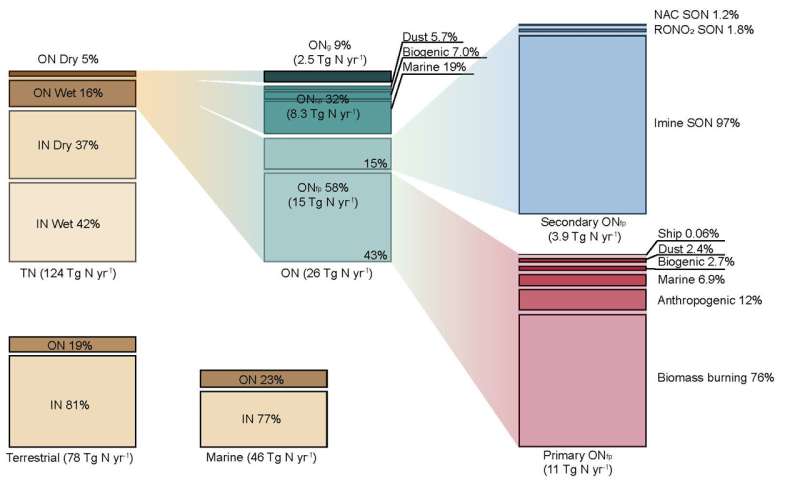This article has been reviewed according to Science X's editorial process and policies. Editors have highlighted the following attributes while ensuring the content's credibility:
fact-checked
trusted source
proofread
Organic nitrogen aerosol is an important contributor to global atmospheric nitrogen deposition, finds study

New research emphasizes the previously underestimated significance of atmospheric ON aerosol depositions on ecosystems. Additionally, the ecological effects of ON aerosol depositions are anticipated to increase due to global warming and the decrease in nitrogen oxide emissions from human activities.
The study was led by Dr. Yumin Li of Southern University of Science and Technology (SUSTech), in collaboration with Professor Tzung-May Fu's team at SUSTech and Professor Jian Zhen Yu's team at Hong Kong University of Science and Technology (HKUST). The research is published in the journal National Science Review.
Atmospheric deposition of organic nitrogen (ON) plays a crucial role in the global nitrogen cycle. Surface measurements showed that 2% to 70% of the local atmospheric deposition flux of total nitrogen was organic. However, previous models have largely neglected the spatial and chemical variations of atmospheric ON, leading to inadequate assessment of its global impacts.
The scientists from SUSTech and HKUST developed a comprehensive global model of atmospheric gaseous and particulate ON, incorporating the latest knowledge on emissions and secondary formations. Their simulated surface concentrations of atmospheric particulate ON (ONp) were highly consistent with global observations, a feat that had not been achieved previously. In addition, their simulated atmospheric deposition flux aligned with global observations within an order of magnitude.
The scientists estimated that the global atmospheric ON deposition was 26 Tg N yr-1. This majority of this deposition (23 Tg N yr-1) occurred in the form of ON aerosol and accounted for 19% of the global atmospheric total N deposition (124 Tg N yr-1). The main sources of ON aerosols were wildfires, ocean emissions, and secondary formation.
"Our simulation showed that the deposition of ON aerosol from the atmosphere is a crucial external source of nitrogen to nitrogen-limited ecosystems worldwide, such as the boreal forests, tundras, and the Arctic Ocean," Fu says.
In a future warming climate, wildfires will likely become more frequent and intense. Climate warming will also lead to surface ocean stratification, making atmospheric ON deposition an increasingly important source of nitrogen to these ecosystems. "We need to further examine the environmental impacts of atmospheric ON aerosol and how those impacts respond to climate change."
More information: Yumin Li et al, Dissecting the contributions of organic nitrogen aerosols to global atmospheric nitrogen deposition and implications for ecosystems, National Science Review (2023). DOI: 10.1093/nsr/nwad244
Provided by Science China Press





















